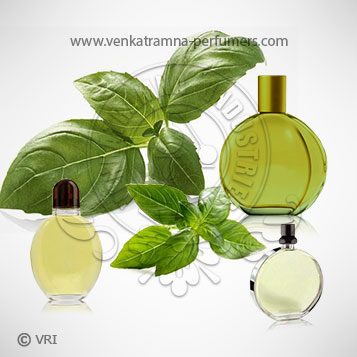
| Botanical Name | Ocimum basilicum |
| Common Name | Sweet basil, common basi, Winter cherry, Indian ginseng, Ajagandha, Ayamodakam, Kanaje, Samm Al Ferakh. |
| Country of Origin | India |
| Solubility | Insoluble in water, soluble in alcohol and oils |
| Specific Gravity | 0.891 – 0.954 @ 72°F |
| Optical Rotation | -14.0 – -5.0 @ 20°C |
| Refrective Index | 1.4795 – 1.568 @ 72°F |
| PlantPart | Leaves |
| Bland With | Bergamot, clove bud, clary sage, geranium, lemon, lime, hyssop, eucalyptus, juniper, neroli, rosemary, marjoram, melissa and lavender. |
| CAS No | 8015-73-4 |
| Flash Point | 167 °F |
| Extraction Method | Hydro Distillation Method |
Holy Basil, also known as Tulasi or as the botanical Ocimum basilicum, ct. Estragole and Ocimum basilicum, ct. Estragole is negative to part of southern India and south east Asia. It is used extensively across India in the practice of Ayurvedic medicine and for spiritual purposes. As a food ingredient the dried herb is very popular in Thai cuisine where is it often called ‘Thai Holy Basil’ (known locally as kaphrao). You will find it in many traditional Thai dishes so look out for it when you next indulge in your Favorite Thai dishes! Although basil grows best outdoors, it can be grown indoors in a pot and, like most herbs, will do best on a sun-facing windowsill. It should be kept away from extremely cold drafts, and grows best in strong sunlight, therefore a greenhouse or row cover is ideal if available. It can, however, be grown even in a basement, under fluorescent lights. If its leaves have wilted from lack of water, it will recover if watered thoroughly and place in a sunny location. Yellow leaves towards the bottom of the plant are an indication that the plant has been stressed; usually this means that it needs less water, or less or more fertilizer.
In Greek its name means 'royal remedy' or 'king'. In the 16th century, powdered basil was used to treat migraines and chest infections. There are many rituals and beliefs associated with basil, which is native to Africa and Asia. The ancient Egyptians believed that it would open the gates of heaven to a dying person, and the Hindus use Basil sprigs to protect the dead from evil while in transition between lives. Western European lore sometimes claimed that it was a symbol of evil, while the Eastern Orthodox Church used it in the making of holy water. Basil is possibly native to India and has been cultivated there for more than 5,000 years. It was thoroughly familiar to the Greek authors Theophrastus and Discords. It is a tender plant, best known as a culinary herb prominently featured Italian cuisine, and also plays a major role in Southeast Asia Cuisines of Indonesia, Thailand, Malaysia, Vietnam, Cambodia, Laos, and Taiwan. Depending on the species and cultivar, the leaves may taste somewhat like anise, with a strong, pungent, often sweet smell.
Color : Pale yellow liquid with Sweet, spicy, fresh aroma,
Aroma : Basil Oil is very famous for its sweet flavor and aroma
Linalool, (-)-bornyl acetate, eugenol and eucalyptol.Methyl Chavicol
It is used for inhalation, in baths and for massages. Having both cold & hot qualities, when it is used in bath or is smoothed over the body, it has invigorating effect that is very beneficial for sluggish skin & pepping up circulation. When combined with other oils like Thyme, it also acts as powerful antiseptic.